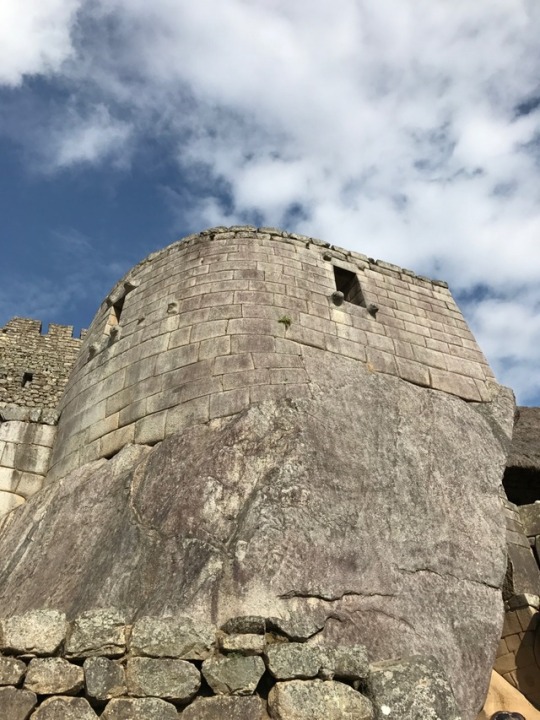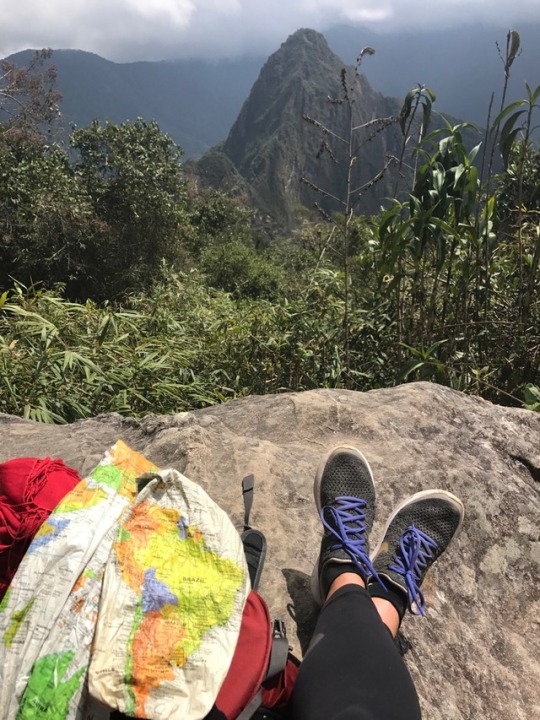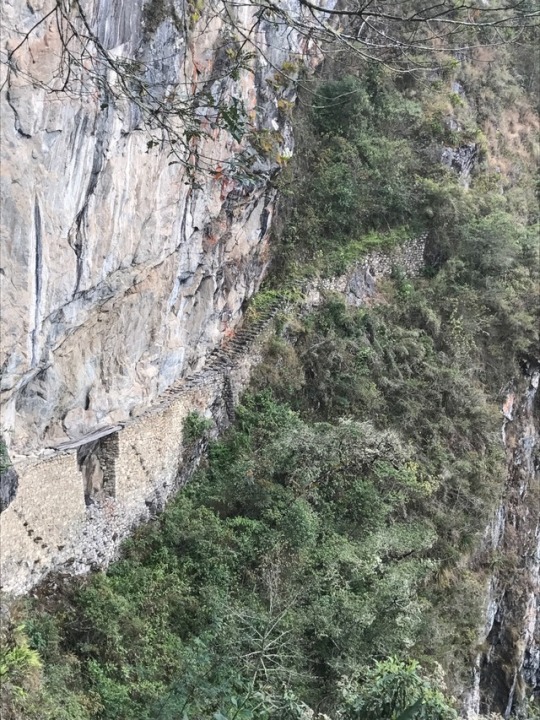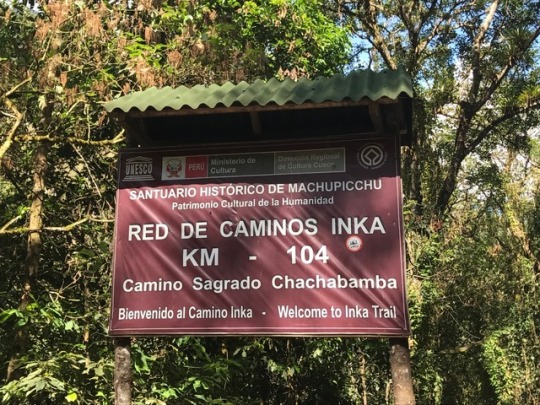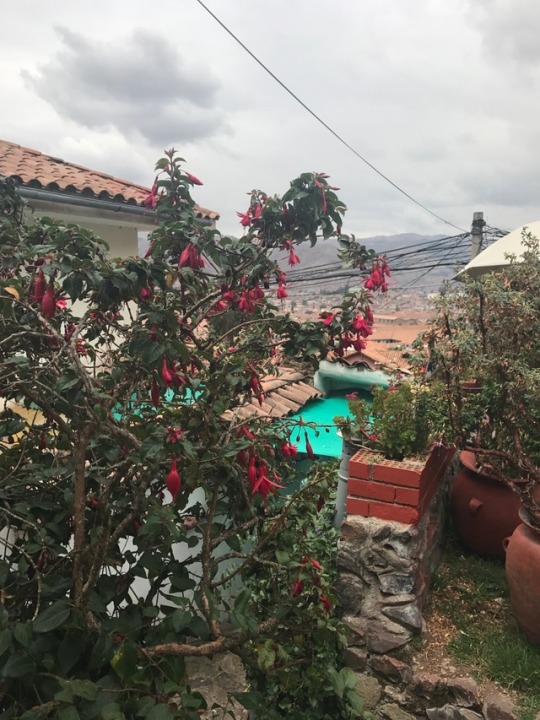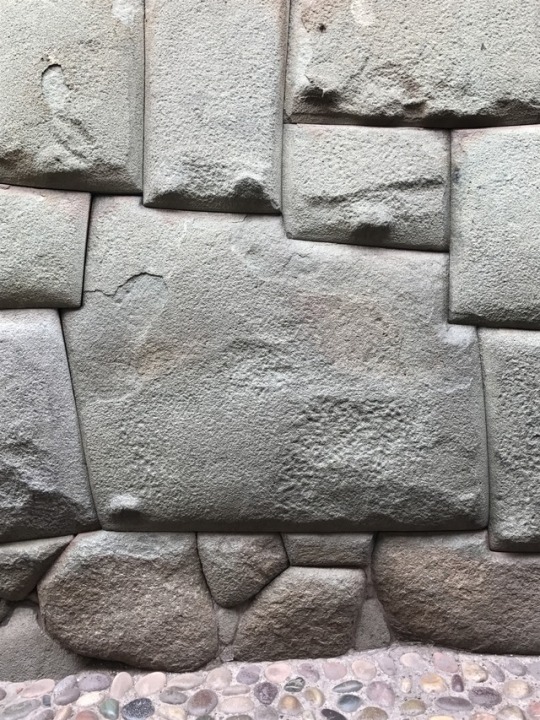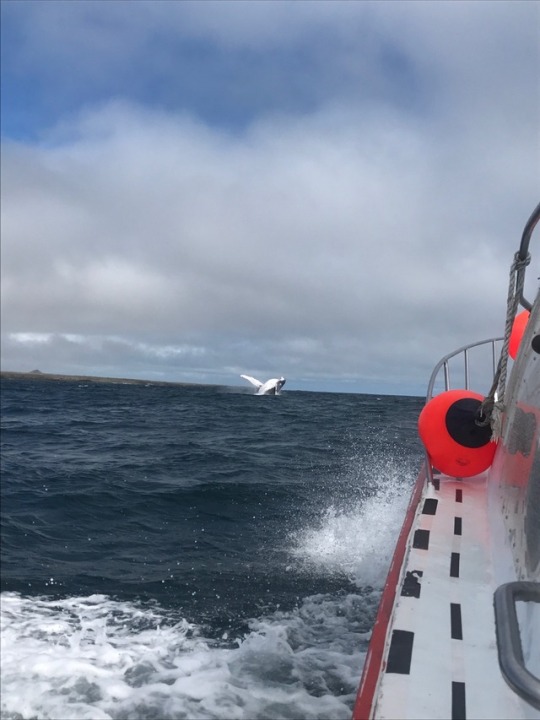Don't wanna be here? Send us removal request.
Text
Time for reflection (Cont’d)
After wiping away my tears I mustered up my last bit of energy for a hike around Machu Picchu mountain (just the base, thank goodness!) to see the Puente del Inca (Incan bridge). If I thought the route out was scary with very narrow paths, incredibly steep cliffs and many tour guides expaining someone died hiking the Inca Trail in 2016 -- the 4 planks of wood that someone had the audacity to call a bridge was utterly terrifying. Don't worry, you're not allowed to cross it! (Not that I would have.)
Then, one more walk through MP and, very sad to be leaving, I headed towards the stairs down. I could have taken the bus, but I wanted to complete the journey from KM 104 to Aguas Calientes, so I opted for the 1,200 meter and ~850 stairs down. As I was about to start I heard Caitlyn call my name and, fed up with the long bus line, the Aussies and Brits decided to walk down with me. It was quite a challenge and halfway down our legs were shaking, but we made it all the way back!
Per my Apple Health app on my phone, in about 30 hours of hiking I clocked in 21 miles and the equivalent of 250 flights of stairs climbed. Accordingly, I guess I shouldn't be too surprised that I spent the next 24 hours in Cusco in a state of extreme nausea, lightheadedness and with swollen ankles from the nastiest bug bites I've ever gotten. At the same time I was anxiously waiting for news from my mom and GHays about hurrican Irma which, from the very little news I was able to access, sounded terrible. When I finally heard they were both alright and houses intact I tried to shrug off my pain, thinking of their strength (especially GHays' at a shelter!) through the storm. I ended up crying 4 different times - I'm sure a mixture of anxiety for them and myself, emotions thinking about my dad and the end of my trip. I guess it's fitting that I'm finishing this post at the exact time my plane is flying over the Mexico - US boarder, so close to going home to San Francisco.
Yesterday I was trying to think about some recurring themes during my trip and the one that kept coming up for me was that no matter how much we talk about globalization or feel more connected to the rest of the world given social media, every culture and land and language and people are so incredibly distinct from one another. The languages we speak and the foods we eat are easy ones to pick out, but I've noticed it's a lot more granular from the extent we follow traffic signals, to the way we decorate our churches, shrines and temples. From how boisterous we are in the streets to how late we stay up at night and what we drink. From how we tote our kids around to the speed of construction and re-construction (development and post-disaster rebuilding). We are a diverse bunch.
With that, I will leave you with a fantastic quote by St Augustine, "the world is a book and those who do not travel, read only one page."
1 note
·
View note
Text
Time for reflection
The next day we were all ready to go by 6am. After a never-ending line, which my SF-brain couldn't handle the inefficiency of, we took the bus from Aguas Calientes back up to the entrance of MP. We walked around with Alberto for a few hours to the main buildings and he gave us a bit more history on the place. Of course, I took notes:
- Why is it called "twice lost" -- the Spanish arrived in 1533 which was just around the time the Incan civil wars were happening. The Incas that lived in MP went to Cusco in 1534 to face the spaniards and left MP abandoned. Then, the last Inca king, around the 1550s sent people to try and repopulate MP, but they left when he was killed and it lay abandoned until the early 1900s.
- In the 1950s, a dictator government took the MP from the private family who owned it. Now, they've filed an international lawsuit to retroactively get admissions fees from the government. ...let's see how that goes.
- The most spectacular building for many in MP is the Temple of the Sun which has a foundation of a huge circular rock base, integrating the architecture with the natural surroundings. On winter solstice (i.e. June 22), the sun rises through the Sun Gate and lights up a small table within the Temple of the Sun, an physics feat given it's about 1 mile away!
- Alberto explained that even though we don't know a lot about their construction, we can guess that they cut the rocks by putting wooden sticks into natural fractures and then watering the wood to expand and help break the rock. This still doesn't explain the alien-like, perfectly fitted stones though.
- They're still discovering new ruins and found the latest site only 4 years ago.
After our tour of the main buildings many people had booked a hikeup Wayna Picchu, the iconic mountain behind MP's stone structures. I waited too long to book though and those hiking tickets were sold out, so I had a bit of free time. I thought about hiking back up to the Sun Gate, but instead stumbled upon a large rock which overlooked a beautiful view of MP. I spent a bit of time here thinking about my trip and how incredibly lucky I am to travel. Along the same lines I pondered how much I take health for granted - as I had seen a man in his 80s, climbing up stairs with his cane just a few minutes earlier. Of course there were many other "pensioners" (as the Brits called them) who took on the steps with relative ease, but most weren't fit enough to do the Inca Trail and waiting to travel until you're older is such a gamble. That of course led me to think about my dad and how much he traveled in his relatively little time and how much more he would have done. I have brought his map jacket along on my adventures and really do believe that in some sense he is experiencing this with me. With the hiking and the history and the Indiana Jones-esque story of MP, I know he would have thought this was the coolest trip. So "we" experienced MP, and that makes me happy.
1 note
·
View note
Text
“Enjoy the walk...” (Cont’d)
I also learned a lot of history from Alberto as we walked, which I found fascinating:
- Machu Picchu was founded in 1450 but abandoned only 100-150 years later, it was likely an Inca University (as Alberto said, the MIT of the Incas!) I thought this was epecially intereting given the way one "became Inca" (or royal) was not solely by birth but by passing a mastery of knowledge test.
- Only the royals (i.e. the Incas) were allowed to hike the Inca Trail and they did it for religious and spiritual purposes. Originally the trail went from Cusco, and took 6-7 days.
- The Spanish never found MP, partly because they killed all the Incas (i.e. the royals) who knew about the place.
- Hiram Bingham (always called "Mr Bingham" by the peruvians in a hysterical spanish accent) was a professor at Yale who found MP while looking for another palace in 1911. There is big controvery about him "discovering" it though, as there were a few farming families who had moved to MP about 9 years earlier because they couldn't afford the taxes of the nearby town. Bingham was lead to the main ruins by a 10-year old boy named Pablo who frequently played up in MP.
Finally, around 4pm we reached the Sun Gate and got our first glimpse of MP. The cool thing about the 2 day tour is that you get to see MP twice, the afternoon of the first day as the sun is setting and there aren't many people around and the morning of the second day when all of the tourists are there, but there is more time to explore. Often, one or both of these times it's foggy or cloudy, but we were lucky and when we arrived it was absolutely gorgeous. A quick hike downhill (wohoo!) and we got to what Alberto effectionately called "his office" and "the postcard view" of MP. This ancient town was incredible and it was one of those moments when you can't stop taking the same picture over and over again, because it's so pretty, even though no picture really does it justice. I must say that I didn't quite get the spiritual feel that so many people describe, but it was quite an experience to see this lost city and to ponder what the Incas were like, how they mastered their architecture and what an incredibly important place this really was.
Later that day I looked up the 7 wonders of the modern world and realized I have been to more than half - MP, Jesu Cristo, the Great Wall of China and the Colosseum. What a lucky woman I am to have travelled so much!!
0 notes
Text
"Enjoy the walk up the mountain, not just the summit."
I woke up at 4am, grabbed my packed breakfast from the front desk of my hotel (a yummy ham and cheese, an apple and passion fruit - which I had to ask someone how to eat) and hopped into a taxi down to the square. We took the bus 1.5 hours to Ollataytambo and I got to see a beautiful sunrise above the mountains. Then we took a train, with excellent cut out windows to watch the mountains pass by, from there to KM - 104 where our 10 mile hike started. I met a few people on the train and everyone else over the day hiking. There was a very talkative Indian girl, Nidhi, and her friend Vidit, from NYC; an Italian couple Gio and Silvia on their honeymoon; a nice British couple, Alec and Alix; a young Aussie couple, Alex and Caitlyn; 3 siblings (?) from San Jose, Andy, Tam and Lynn; and 3 nurses from Canada, Cathryn, Emily and Roma. I was the only person doing the trek alone but it almost made it better as I was able to easily weave between the groups and chat with everyone, including our guides, Alberto and Charley. After we got past passport control (no kidding, they're very strict with who hikes the Inca Trail), we took the opportunity to reapply sunscreen and bug repellant and got on our way! We hiked from about 9:30 until 4:30, with a short stop for lunch. A few of the girls were experiencing alitude sickness and there were a few significant climbs, so we went slowly but that was alright with me as I got to spend a bit more time taking it all in. A few highlights: - Chacha-bamba which was our first stop with a few stone buildings. It was a sort of way station that had dorms and food, just around the KM 104 point. - Over the river and through the woods... Intipata, the Sun Terrace, was the next bit of ruins we saw - gorgeous terraces on the mountaintop that faced the sun. Nidhi noted that to her, it looked like a man falling, and I suggested that might be her subconscious telling her to stay on the inner part of the path! - Winyawayna (which translates into Forever Young) was, in my opinion, the most fascinating stop on our trek. It was a huge terraced land with a 350 stair climb that the guides affectionately knick-named the "gringo killer." They found this place in 1950 after, no joke, following an Andean panda bear here! Since there were so many terraces, they were likely used for agricultural experimentation of corn and potatoes - There were tons of other ruins along the path, many of which had not been restored so they simply looked like stone structures with a lot of overgrowth. For some reason I can't figure out, they used seeds as part of the mortar for these terraces - not a great idea when you're in a jungle and seeds tend to grow into plants... just saying.
0 notes
Text
Cristo, cappuccino and check-in around Cusco
The next day I planned to take it easy, as I wanted to be ready for my trip to Machu Picchu. I planned to see a few of the last sites that I had on my list, do some shopping and enjoy the city. One of the top things to see was the Cristo Blanco, a white stone sculpture of Jesus (similar to the Jesu Cristo in Rio) on top of a hill. Looking at a map it was just a very short distance from my hotel, but I soon figured out that was measured as the bird flies and us humans have to also deal with elevation. That 0.2 miles was about 600 feet up and by the time I reached Cristo, my legs were singing. The view of Cusco from the top of the hill was incredible, and well worth the visit, but next time I would suggest a bus ride. I walked back down into the city center and made a point to stop by the stone with 12 corners. One of the incredible feats of the Incas was that they were able to perfectly fit stones together so that they didn't need any mortar to hold the structure together and not even a pin would fit in between them. They only did this masterful work on special structures (royal Inca palaces and religious buildings mostly) but the time and skill involved in cutting the rock (with nothing but bronze tools), polishing it and then fitting it together with its neighboring pieces is magnificent. Right after the stone I stumbled upon Kuna, which is a high end sweater, scarf and pashmina shop. I decided awhile ago that pashminas would be my signature accessory, so I had to take a look. The items were gorgeous, mostly alpaca but with some silk blends as well. Let's just say that I spent about an hour in the store and I had to buy an extra bag later that day to bring all of my goodies home! Next I spent a few hours on the Plaza de Armas sitting on the balcony of a second floor cafe, drinking cappuccino while admiring the view of their cathedral and doing a bit of writing. I ordered a $3 fruit and yogurt dish and they brought me a massive banana split bowl with papaya, bananas, peaches and yogurt - oh, how I will miss the fresh fruit! Finally, I headed to my check-in at Llama Path for the next day's tour. We were told to meet in the square at 5am, to pack lightly because we would be carrying our backpacks the entire 10 mile trek, but also leave enough room for lunch, water and an energy drink which they would give to us in the morning, to also carry. Then, to bed!
0 notes
Text
First the valley... (Cont'd)
Next, and as the sun was sinking behind the mountains, we headed up to Chinchero which is a town that stands at 3,850m (or almost 14,000 ft). The guide told us that they've been planning an international airport in this town - but "the pilots won't like it because of the heavy winds." Eeeek! The town was gorgeous though and we stepped off the bus literally into a procession of people celebrating la Virgen. The religious procession had already moved through the town to the main square but we joined the laggards, dressed as drunk Incan cowboys with pinocchio masks and lots of beer. So fun! Our final stop was at a lovely little building that housed weavers. They explained how they use a special soap to clean the wool, how they spin it and finally how they use all natural dye - everything from purple corn to green plans to red from bugs they "harvest and sacrifice" from cactus! I bought a beautiful white scarf they had made. It was a long, but great day, though I was very happy to get back to Cusco and get off the bus. I was craving something healthy and found a lovely salad at a place called Organika. To top off the #sosahnfrahn experience I ordered with a glass of savingon blanc. Delicious!
0 notes
Text
First the valley, then the mountains
Yesterday morning I woke up around 6, had a lovely breakfast (good omlete, plentiful fruit and interesting cereal) and headed down to the Center for my tour of the Sacred Valley. I met a few nice couples, we got on a big tour bus and our guide Adriel introduced himself. He had grown up in the Sacred Valley, in Ollanteytambo, the 10th child of 11! As we left Cusco he explained that in quechua it's pronounced "Cos-co" and means spiritiual center of the Andes. He was a wealth of information, though later comments made me believe only 60-90% was correct - so please take the rest with a grain of salt. On our way, he talked to us about how the quechuan people grew most of their crops here in the valley. Over 5 seasons they would grow potatoes, then lima beans, then quinoa and finally barley - leaving the land barren the last year before the crop cycle started again. We stopped to see llamas, alpacas and vacunas - animals that he said came down from N America after the last ice age. Although the incas domesticated them, they can only take about 20kg (less than 50lbs) and they are lazy, often stopping for breaks. They're super sweet and we were given barley to feed them - our first of many photo ops. The next stop was Pisaq where we saw our first bit of terraced land. It was first thought (and reported by National Geographic in the 80s) that the terraces were used for farming, but if you think of the population size - the enormous amount of terraced mountain sides makes no sense at all. Instead, it's thought that the Incans moved to the mountain tops for safety, because empire building makes a lot of enemies - and these terraces support the mountains from land slides, etc. After the terraces were built though, it's likely that they used the land to experiment with agriculture - including the 4,000-5,000 different types of potatoes they cultivated. After a bit more driving we stopped for lunch and I tried another type of drink, chicha beer, made of fermented corn. Although it has a strikingly beautiful purple color, it was way too sweet for my taste, and that's saying something! I also tried alpaca which was a beautifully tender meat - yum! Then more driving, past tons of little cities with one main road, lots of old houses, many made with clay and sometimes stone. It seemed as though most of the citie specialized in something - from gineapig roasted on a stick, to fresh chicha and some simply serving tourists lunch. The next big Inca site was the city of Ollantaytambo, and much of the old city was preserved with its ancient canals that carried natural water from the mountains. The terraces were well preserved here, exept for a few top levels of stone which, reportedly, had been thrown down into the valley at spaniards who came to invade the small town in 1536. The most amazing part of this town though were the absolutely enormous and precisely cut stones - many were over 70 tons and had been brought from miles away via rollers - down a mountain and then back up another via their Inca Trail. And I've been complaining about my day pack. Still a mystery though is how they perfectly cut the stones which fit together precisely to form very strong architecture which has survived over 500 years.
0 notes
Text
Cusco, mucho mas que Incas
After Stephen and I had one last run around Miraflores and at at La Lucheria sandwich shop one more time (the mango milkshake was amazing, but Tulipan's is still the best), we headed to the airport. Oddly, this airport that serves a population of 10 million is only one terminal, but eventually we had to part as he went International back to SF and I headed to Domestic departures, headed for Cusco. It was a short flight but I took advantage of the free drink offer to try some Inka Cola which is a bright yellow soda that is everywhere you look in Peru. About half of the people on my flight also opted for Inka Cola so I was feeling pretty good about my choice until I tried it. Super gross. Later, a tour guide explained the drink as banana and pineapple flavored, but really is sort of bubblegum tasting. Only a disgustingly fake flavor could possibly achieve those two tastes, in my point of view. I made it into Cusco and grabbed a taxi to my hotel. The driver navigated the super narrow and cobblestone streets well but later dropped me off at the bottom of a staircase and told me my hotel was above. With my hiker's pack and backpack on, I suddenly felt the effects of elevation, in this city 11,000 - 12,000 feet above sea level and after just 10 steps I was instantly out of breath. The hotel wasn't as close as the driver had promised, but I found it nonetheless and was given some coca tea which is the natural cure. It may have helped a bit, as I didn't get ill, but I did walk around the rest of the day in a weird state of drunken slowness. (Not as much fun without the party!) After regaining some strength, my first stop was a walk down to the Center to Museo del Inca. I had a great little guide give me a tour and explain some important history of both the Incas and (perhaps even more interesting) the pre-Incan people that aren't often talked about. The Incas were only around from ~1200 - 1500 AD, but pre-Incan civilizations in Peru date all the way back to 20,000 BC. The first peoples were hunters and gatherers, but as time went on and they created new civilizations and learned how to make beautiful ceramics, a pre-cursor to farming. I also learned that the people we often refer to as "incan" should really be referred to as Quechua, because "Inca" only applies to the royal family. Although they started cementing their empire in the 1200s, the last three Incan kinds were really the ones to grow the empire throughout the entire Andean region (up through Ecuador, into Bolivia and down through Chile). The last Incan kings were brothers and one lived in Quito and ruled the North with the other in Lima, ruling the South. They were not on great terms when the Spaniards arrived and the northern king paid the Spanairds two rooms of gold and one of silver to assasinate his brother. This was an important step in the beginning of the end for the empire. It also didn't help that the spaniards resembled Incan gods (atop their horses with metal armour) and that they brought diseases which destroyed much of the Incan population. Sadly, the spanairds also managed to hide the advanced intelligence of the Incans and permanently destroyed their counting and writing systems - though we can tell by their construction that they must have had a very good understanding of physics and architecture. After the museum I checked in with my tour company and went a delicious restaurant for dinner. I had a pisco sour, flavored with the purple morada corn and pasta and chicken main with tons of fresh veggies. I must say that Cusco surprised me in both its scale (a population of about 500,000) and a gorgeous colonial city. Writing this, I'm sitting in the main plaza in front of one of the beautiful stone churches. After dinner, I headed back to my hotel. It's a nice little boutique hotel on a really pretty property with a big garden but I fell in love with the place when I got under my covers and found a hot water pack that kept my feet warm until the next morning. WOW!
0 notes
Text
Gastro-tourism (cont'd)
- Favorite starter: Desert Plants (180m) which were a few different types of tumers, my favorite being the sweet potato leaf. Who knew the leaves were delicious?! - Best presentation: Waters of Nanay (680m) which consisted of piranhas skin that was served amidst frozen piranhas heads - teeth and all! - Made me feel like Pumba from Lion King: In Forest Cotton (300m) they served us grub (i.e. river snail) in a leaf! It was literally the Hakuna Matata scene. I actually liked this dish though, but more for the cotton fruit which has cotton texture and a sweet taste. - Dish I just couldn't handle: Marine Soil (0m) when I remembered why I don't like sea urchin. Honestly, does anyone? - Star sighting: Somewhere about here in the meal Stephen spotted Virgilio (!!!!) and the waitress told us that we were sitting just outside of his office. So cool! - Best food + drink combo: Land of Corn (2010m) was a dish where they literally used every part from balls with cream of corn, to the silk (those annoying stringy bits) roasted on top and a sauce made with corn husks - all paired with chichamorada beer (made with fermented corn)! - Prettiest ingredient: Colors of Amazonia (450m) with the paiche fish which was served as a thread, dark pink outside and white on the inside. - Yummiest main: Low Andes Mountains (1800m) with the most amazing pork belly I've ever had, not too much fat and perfectly tender meat. - Wackiest overall: Humid Green (3700m) which we weren't sure at first if it was dessert or a main until we started enjoying the subtle sweetness. He also made a very light brush of smoke to add a bit of darkness to the plate - absolutely wild. - The funniest thing: The fact they had to tell us what part of each dish we were supposed to eat, so we wouldn't gnaw on the serving spoons and decorative animals and minerals they served dishes on. We started our culinary adventure at 8:30 and by the time we finished the last of 3 dessert courses it was almost midnight! We stumbled downstairs (that was a lot of drink pairings!) and as they were closing up they let us check out where the magic happens, in the kitchen. Later when we were re-watching the Chef's Table episode we realized the place we took a picture in the kitchen is part of the show's opening credits. #starstruck
0 notes
Text
Gastro-tourism at its haughtiest!
Most people would not describe me as an "adventurous eater," but I was super taken by the Chef's Table episode that described Virgilio's Elevation menu at his Lima restaurant called Central. His vision was to create a menu that took diners through Peru's many elevations and ecosystems and introduce them to tastes and ingredients that they would never imagine trying. And in the most eco-diverse country in the world, with 4,000 different kinds of potatoes, there is a LOT to work with. This "picky eater" was very excited to travel all of Peru in 3 hours of eating! Before we headed to the restaurant we made a quick stop at Lima's #1 attraction, the Circuito de Magico de Agua which is a water fountain park that has about 10 different themed water exhibits and nightly shows water fountain shows (think the Vegas Bellagio but with more colors). The child-like joy I got from dancing colored water was worth the ~$15 we spent on the entire experience, but not much more. Then the main event. We took our seats next to a giant rock table with little wells cut out that contained many of the ingredients we would later be eating - a tool for the waiters to explain the dishes (and the exact table featured in Chef's Table)! What followed were 17 courses that went from -10 meters (sea food caught just off the coast) to a whopping 3700 meters, in the highest mountains. To accompany the food, we went with the drink pairing which consisted of 2 cocktails, a sour beer and a number of different wines (honestly, I lost count by my guess is about 7...and a sherry). I won't go through everything, but a few highlights: - Weirdest thing that I liked: the Rock Molluscs dish (-10m) which consisted of sea snail, mussel and limpet, that we ate via a sargassum cracker.
1 note
·
View note
Text
Exceeding expectations in every way!
I have been wanting to go to Lima for awhile now. I remember Yael went after our study abroad in Buenos Aires back in 2007, then I dreamed of going when Carmen-Rosa would proudly tell me about the incredibly diverse ecosystems. So when I was planning my TOAL (trip of a lifetime) it was the main figure of my South American trip. Then, Stephen said he would join this part of my journey to go to the Galapagos and would add a few days with me in Lima. A beautiful trip was in the making. After 5 days in the Galapagos and an afternoon in Guayaquil, I was very excited to be back in a major city and a nice Airbnb apartment. We landed in Lima just after 8pm and quickly made our way to an Uber. I was really surprised on the drive in, just outside of the airport gates that the city seemed very gritty and less developed than I originally thought. Then we entered Miraflores which looked a lot more like what I expected, a lot like the nicer neighborhoods in BA. The apartment was in a very old building but was beautifully remodeled and about 4x bigger than any room we had been in the past few days. After dropping our bags we headed to Panchita for dinner. I had been dreaming about this meal for awhile and sorted through the 6 page menu until I found lomo saltado. And I think it goes without saying that I had to order a pisco sour - but opted for the doble version called El Catedral. Obviamente. It was absolutely amazing. I suggested we do a run the next morning, both because we only had 1 day in Lima and because I love exploring cities through running -- something I just decided to call "corri-tourism." (More on this later.) Stephen consulted the Airbnb host and devised an awesome 5 mile route through the posh Miraflores neighborhood and along the coast. The route was beautiful with a center median for pedestrians so we could avoid most of the morning traffic and then a long beach-side boardwalk along the cliffs that line Lima's beaches. The beach scape was really breathtaking and we stopped for a few pictures (and a kiss!) at the Parque del Amor. After the run we showered and hungrily made it to La Lucha, a very popular sandwich shop close by. I had an incredible jamon y queso and huge cappuchino with plenty of chocolate powder and we vowed to come back the next day. We hailed an uber and made it into the more historical part of Lima - a few miles North. We walked around Plaza San Martin and into the famous Hotel Bolivar. We just wanted to take a peek and when the hostess asked if we were hotel guests I thought we would be turned away, but she ended up giving us a 20 minute tour of the hotel, showing off both the first elevator and the first car in Lima. What a great unexpected surprise! Then we walked to the grand Plaza Mayor which was really a sight with the Catedral, City Hall and the Presidential Palace. We spent a bit of time in the Catedral which we learned housed the remains of Francisco Pizarro! There was also a really cool huge painting that recounted all the past emperors of Peru - and literally went from Native Inca kings to Colonial rulers - so interesting. We stopped by Iglesia de San Francisco, but decided not to go all the way in given all the reviews I said explained that the catacombs had a kind of creepy display of bones. Instead, we opted for a light snack (and a pisco sour for me!), before heading back to get ready for the main event of Lima - dinner!
0 notes
Text
Guay y Quil
We woke up early for our last morning on the Galapagos and I had a delicious "American" breakfast of buttery bread, fruit, scrambled eggs and instant coffee. Stephen opted for the traditional bolones con queso (ball of fried plantains with cheese). El abuelito drove us back to the ferry which we took back to Baltra. In my mind, we almost missed our flight but in Stephen's consultant craziness, we were close but with plenty of time. When we landed in Guayaquil, we had a few hours layover. We found some luggage lockers and grabbed a $3 cab into the city. Stephen had found a great sandwich place in the center, but when we arrived, we didn't see any menu that mentioned sandwiches...and later realized the place had been sold to a more "local" lunch spot. We ordered the local fare which consisted of fruit juice, caldo (soup), grilled chicken and rice with a small salad and jello (obviously). I'm not going to lie, I closed my eyes on a couple of bites of the soup, but it was fine. When we went to pay and the cashier said $6, I had to confirm that was "juntos" (together). It was. With our extra lunch money, we went to a coffee shop and ordered two delicious and enormous desserts - who knew there was a cuatro leches cake?!?!?!?!? Great invention. To walk off some of the sweets we headed to the Malacon which is the boardwalk along the water in Guayaquil. It was sunny and it was hot. I wouldn't necessarily say it was picturesque, but it was family friendly with lots of little rides. Then, to Las Penas - the old town on the hill. Stephen had done some research and we walked up more than 400 steps in the heat of the afternoon. At the top of the hill (which was once a very important military lookout), there was a gorgeous view of the city and some very poorly translated plaques of the Spanish rule. To me, the coolest part was the blue and white lighthouse (matching the Guayaquil flag) and the adorable little church on top of the hill. (There was also a very cute black and white kitty meow-ing its way around the square - I miss Jack!) Then, time to head back to head back to the airport. Let's try not to remember how the Uber driver got a ticket for picking us up -- Uber is questionably legal in many South American countries, including Ecuador! Next stop... Lima.
0 notes
Text
Swimming with Sharks (cont'd)
Though we didn't actually eat the fish that the guide caught, I wasn't kidding about the ceviche. Given my distaste for fish, I was not super excited about the prospect of eating it on a boat. I also didn't want to be that picky-eater American though, so I withheld my comments. I could always eat later, right?! When we had boarded that morning, they had brought the fish onboard in a clear plastic baggy and tossed it next to the snorkeling gear - greaaaat. As we were trailing along the coast of Pinzon the cook was chopping away - onions, cilantro, tomatoes, and finally squeezing orange juice over the fish. After a bit more snorkeling, we came back on board for lunch and I dipped some grouper ceviche into my bowl with mounds of plantain chips - hopefully with enough salt to disguise any of my disgust. I held my breath and took a bite - it wasn't that bad! Because the orange had cooked the grouper it wasn't the terrifying raw fish experience I expected. Phew! On the way back there was talk about more snorkeling, but after the last jump into freezing water, people were less enthusiastic. Good thing, because when we started, we found out we would have to go back to Puerto Ayora pretty slowly. Everyone settled into their boat napping (extremely common here to just pass out), until the guide yelled "ballena!" Even though I've forgotten many animal vocab words (I couldn't remember pig yesterday), I remembered "whale!" It was absolutely incredible - for the next 20 minutes we drove alongside him as he (she?) majestically jumped through the water again and again. Sometimes it feels as though the animals in the Galapagos are part of the tourism business in the Galapagos, posing so we can all bring incredible photos along with the living zoo stories we take back home. She was SO beautiful and we got an excellent chance to see her frolicking through the waves - completing one of my lifelong dreams! After we lost the whale I continued my napping. We woke to the boat stopping just outside of Isla Fe - another snorkeling destination. We were all very hesitant to get out of the boat and, as we would later find, for good reason… It was cold when we got in (surprise, surprise!), but I warmed up relatively quickly, as my body must be getting used to the abuse. We saw some bigger turtles and then moved onto the beach where we found some sea lions sleeping. They were so cute, lying on their backs with their little paws resting on their chests and having little sea lion dreams! We saw some more iguanas, though now I laugh thinking back at the first day when I was so taken by them, as they're a common event here. We got back in the water and saw another shark and another turtle - again, amazing wildlife that I've somehow gotten used to here in the Galapagos. Back on the boat, after taking a few minutes to dry off, we were told that the last engine battery was dead. Hmmm. We waited and, an hour later, a boat came with a fresh battery. We were all quite tired when we got back to the port, 3 hours later than expected. The owner of the tour offered us lobster dinner though, so we went back to Kiosko street and ate together - the least he could do! (Please let the record show that I ate two seafood meals in one day... and because of that, we went to a kiosk on the way back and bought dessert, nuts and a beer - to celebrate my seafood victories.) What a day!
0 notes


